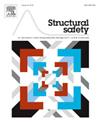MetaIMNet:一个基于物理信息的神经网络架构,用于在时变危险载荷下的替代响应和易损性建模
IF 6.3
1区 工程技术
Q1 ENGINEERING, CIVIL
引用次数: 0
摘要
地震和飓风等极端事件会对建筑物和桥梁等基础设施资产造成广泛的破坏和破坏。巨灾建模和准确的极端事件风险和恢复能力评估需要这些资产的投资组合级脆弱性函数,其中涉及建立相关峰值响应量(也称为工程需求参数(EDP))与选择表征灾害的特征之间的函数关系。考虑到分析几种危害和结构特征的统计组合的计算需求,同时对每种组合进行非线性时程分析,将峰值EDP与输入时程的相关强度度量(IMs)关联起来的替代需求模型很受欢迎。传统上认为,先验确定的峰值加速度和速度、平均速度和峰值谱加速度等传统IMs是响应和损害的有效预测指标,但在脆弱性模型开发中使用它们作为替代模型会引入额外的模型不确定性。为了实现更健壮和准确的代理建模,我们提出了MetaIMNet;基于神经网络的物理信息框架,同时从负载的时间历史中提取关键特征,并利用这些特征进行结构特定响应预测。该框架通过一个案例研究进行了说明,该案例研究表明,它以与模型训练相关的名义上增加的计算成本优于传统的代理建模策略,并且可以用作有效的代理模型,用于为广泛的危害和结构开发脆弱性函数。本文章由计算机程序翻译,如有差异,请以英文原文为准。
MetaIMNet: A physics-informed neural network architecture for surrogate response and fragility modeling of structures subjected to time-varying hazard loads
Extreme events such as earthquakes and hurricanes cause widespread damage and disruption to infrastructure assets such as buildings and bridges. Catastrophe modeling and accurate extreme event risk and resilience assessment require portfolio-level fragility functions of these assets, which involve the establishment of functional relationships between a relevant peak response quantity, also known as the engineering demand parameter (EDP), and select features characterizing the hazard. Given the computational demands of analyzing several statistical combinations of hazard and structural features, while running nonlinear time history analyses for each combination, surrogate demand models relating peak EDP to relevant intensity measures (IMs) of the input time history are popular. Although traditional IMs such as peak accelerations and velocities, average velocities, and peak spectral accelerations determined a priori have been traditionally found to be effective predictors of response and damage, their use in surrogate models in fragility model development introduces additional model uncertainties. In a bid to enable more robust and accurate surrogate modeling, we propose MetaIMNet; a physics-informed framework based on a neural network that simultaneously extracts key features from the time history of the load and leverages these features for structure specific response prediction. The framework is illustrated through a case study which shows that it outperforms traditional surrogate modeling strategies at a nominal added computational cost associated with model training, and can be used as an effective surrogate model for developing fragility functions for a wide range of hazards and structures.
求助全文
通过发布文献求助,成功后即可免费获取论文全文。
去求助
来源期刊

Structural Safety
工程技术-工程:土木
CiteScore
11.30
自引率
8.60%
发文量
67
审稿时长
53 days
期刊介绍:
Structural Safety is an international journal devoted to integrated risk assessment for a wide range of constructed facilities such as buildings, bridges, earth structures, offshore facilities, dams, lifelines and nuclear structural systems. Its purpose is to foster communication about risk and reliability among technical disciplines involved in design and construction, and to enhance the use of risk management in the constructed environment
 求助内容:
求助内容: 应助结果提醒方式:
应助结果提醒方式:


